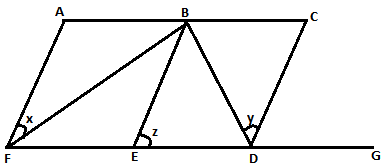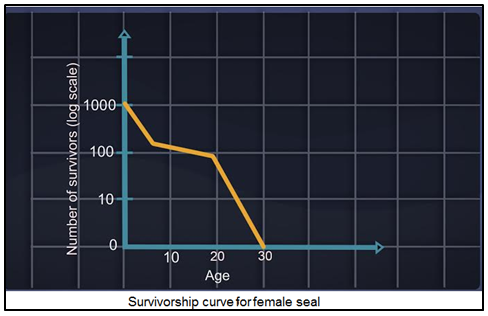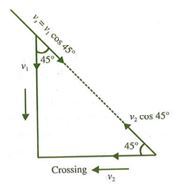12th Grade > Physics
SOUND MCQs
Total Questions : 31
| Page 2 of 4 pages
Question 11. Two sound sources are moving in opposite directions with velocities v1 and v2(v1>v2). Both are moving away from a stationary observer. The frequency of both the sources is 900 Hz. What is the value of v1–v2 so that the beat frequency observed by the observer is 6 Hz? Speed of sound v = 300 m/s. Given that v1 and v2 ≪ v.
Answer: Option B. -> 2 m/s
:
B
f1=900(300300+v1)≅900(1+r1300)−1900−3v1
Similarly,
f2=900(300300+v2)=900−3v2f2−f1=6∴3(v1−v2)=6∴3(v1−v2)=6orv1−v2=2m/s
:
B
f1=900(300300+v1)≅900(1+r1300)−1900−3v1
Similarly,
f2=900(300300+v2)=900−3v2f2−f1=6∴3(v1−v2)=6∴3(v1−v2)=6orv1−v2=2m/s
Question 12. A train has just completed a U-curve in a track which is a semi-circle. The engine is at the forward end of the semi-circular part of the track while the last carriage is at the rear end of the semi-circular track. The driver blows a whistle of frequency 200 Hz. Velocity of sound is 340 m/s. Then the apparent frequency as observed by a passenger in the middle of the train, when the speed of the train is 30 m/s, is
Answer: Option C. -> 200 Hz
:
C
The Doppler formula holds for non-collinear motion if vs and v0 are taken to be the resolved component along the line of slight, In this case, we have

v0=−vtsin45∘=−30√2m/s
vs=−vtsin45∘=30√2m/s
We have, v = 340 m/s, n = 200 Hz. The apparent frequency n’ is given by
n′=n[v−v0v−vs]=200[340+(30√2)340+(30√2)]=200Hz
:
C
The Doppler formula holds for non-collinear motion if vs and v0 are taken to be the resolved component along the line of slight, In this case, we have

v0=−vtsin45∘=−30√2m/s
vs=−vtsin45∘=30√2m/s
We have, v = 340 m/s, n = 200 Hz. The apparent frequency n’ is given by
n′=n[v−v0v−vs]=200[340+(30√2)340+(30√2)]=200Hz
Answer: Option D. -> 10
:
D
When the man is approaching the factory,
n′=(v+v0v)n=(320+2320)800=(322320)800
When the man is going away from the factory,
n"=(v−v0v)n=(320−2320)800=(318320)800∴n′−n"=(320−318320)800=10Hz
:
D
When the man is approaching the factory,
n′=(v+v0v)n=(320+2320)800=(322320)800
When the man is going away from the factory,
n"=(v−v0v)n=(320−2320)800=(318320)800∴n′−n"=(320−318320)800=10Hz
Answer: Option D. -> 117 dB
:
D
Intensity,
I=PA=200π4π×(10)2=0.5W/m2
Loudness = 10log10II0=10log100.510−12
=10log10(5×1011)
=10log10(10122)
= 117 dB
:
D
Intensity,
I=PA=200π4π×(10)2=0.5W/m2
Loudness = 10log10II0=10log100.510−12
=10log10(5×1011)
=10log10(10122)
= 117 dB
Answer: Option A. -> 56.2 cm
:
A
Apparent frequency is given by:
n′=n(vv−vs)
For a medium, frequency is inversely proportional to wavelength.
λ′=(v−vsv)λ
λ′=(320−20320)60
λ′=56.25cm
:
A
Apparent frequency is given by:
n′=n(vv−vs)
For a medium, frequency is inversely proportional to wavelength.
λ′=(v−vsv)λ
λ′=(320−20320)60
λ′=56.25cm
Answer: Option B. -> 6
:
B
When the train is approaching,
n1=vv−vs×n=320320−4×243=8079×243
When the train is receding,
n2=vv+vs×n=320324×243=8081×243
Beat frequency is
n=n1−n2=80×243(179−181)=6Hz
:
B
When the train is approaching,
n1=vv−vs×n=320320−4×243=8079×243
When the train is receding,
n2=vv+vs×n=320324×243=8081×243
Beat frequency is
n=n1−n2=80×243(179−181)=6Hz
Answer: Option A. -> 6
:
A
Apparent frequency due to train which is coming in is
m1=vv−vsn
Apparent frequency due to train which is leaving is
m2=vv−vsn
So the number of beats is
n1−n2=(1316−1324)320×240⇒n1−n2=6
:
A
Apparent frequency due to train which is coming in is
m1=vv−vsn
Apparent frequency due to train which is leaving is
m2=vv−vsn
So the number of beats is
n1−n2=(1316−1324)320×240⇒n1−n2=6
Question 18. Two cars are moving on two perpendicular roads towards a crossing with uniform speeds of 72 km/h and 36 km/h. If second car blows horn of frequency 280 Hz, then the frequency of horn heard by the driver of first car when the line joining the cars makes angle of 45∘ with the roads, will be (velocity of sound is 330 m/s)
Answer: Option C. -> 404 m/s
:
C
The frequency that the observer receives directly from the source has frequency n1=500Hz. As the observer and source both move towards the fixed wall with velocity u, the apparent frequency of the reflected wave coming from the wall to the observer will have frequency
n2=(VV−u)500Hz
where V is the velocity of sound wave in air. The apparent frequency of this reflected wave as heard by the observer will then be
n3=(V+uV)n2=(V+uV)(VV−u)500=(V+uV−u)500
It is given, that the number of beat per second in n3−n1=10
∴(n3−n1)=10=(V+uV−u)500−500=500[V+uV−u−1]10=2×u×500V−uHence,10V=1000u+10u=1010uPuttingu=4m/s,WehaveV=110[4040]=404m/s
:
C
The frequency that the observer receives directly from the source has frequency n1=500Hz. As the observer and source both move towards the fixed wall with velocity u, the apparent frequency of the reflected wave coming from the wall to the observer will have frequency
n2=(VV−u)500Hz
where V is the velocity of sound wave in air. The apparent frequency of this reflected wave as heard by the observer will then be
n3=(V+uV)n2=(V+uV)(VV−u)500=(V+uV−u)500
It is given, that the number of beat per second in n3−n1=10
∴(n3−n1)=10=(V+uV−u)500−500=500[V+uV−u−1]10=2×u×500V−uHence,10V=1000u+10u=1010uPuttingu=4m/s,WehaveV=110[4040]=404m/s
Answer: Option D. -> 403.3 Hz to 484.0 Hz
:
D
Frequency heard by the observes will be maximum when the source is in position D. In this case, source will be approaching towards the stationary observer, almost along the line of sight (as observer is stationed at a larger distance).
nmax=vv−vsn=330×440330−1.5×20=484Hz

Similarly, frequency heard by the observer will be minimum when the source reaches at position B. now, the source will be moving away from the observer.
nmax=vv+vs×n=330330+1.5×20×440=330×440360=403.3Hz
:
D
Frequency heard by the observes will be maximum when the source is in position D. In this case, source will be approaching towards the stationary observer, almost along the line of sight (as observer is stationed at a larger distance).
nmax=vv−vsn=330×440330−1.5×20=484Hz

Similarly, frequency heard by the observer will be minimum when the source reaches at position B. now, the source will be moving away from the observer.
nmax=vv+vs×n=330330+1.5×20×440=330×440360=403.3Hz

















